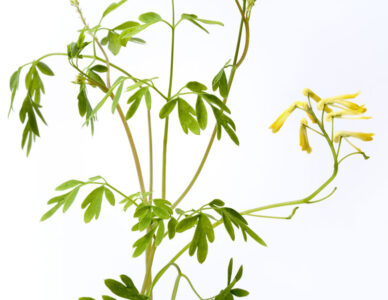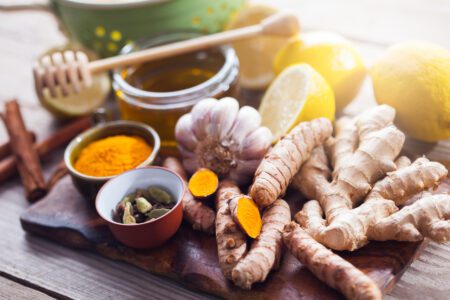Regardless of how conscientious we are about our health and fitness, our bodies are under constant assault from pollutants. Many toxins are as close as the air we breathe–the Environmental Protection Agency tracks levels of 187 toxic air pollutants under the Clean Air Act–and the foods we eat, which routinely harbor additives, preservatives and pesticides. The personal choices we make, including our consumption of sugar, caffeine, alcohol and tobacco, can add to our toxin load.
Although our bodies are designed to efficiently eliminate toxins, the sheer volume of pollutants we encounter every day can tax our natural detoxification systems. It’s best to maintain a healthy diet and avoid toxins all the time, but if you’re looking for a spring jump start, try the whole-food detox menu below. Please note: Detox regimens are intended for short-term use. Always consult your health practitioner before changing your diet or health program, particularly if you have a pre-existing health condition.
Detox Menu
Promote healthy liver function by following this detox menu for a week. Supplement it with as much herbal tea as you like. (Try one of our favorite detox tea recipes from our sister publication, The Herb Companion: “Liver Tea.”) For convenience, steam many servings of vegetables ahead of time and save the vegetable water; it’s part of the menu.
Upon rising: Drink two glasses filtered water–one glass with half a lemon squeezed in.
Breakfast: Eat one piece organic fresh fruit such as apple, pear, banana, grapes (about a cup) or citrus fruit.
15 to 30 minutes later: Eat one bowl cooked organic whole grains, specifically millet, brown rice, amaranth, quinoa or buckwheat. Flavor grains with 2 tablespoons organic fruit juice for a sweet taste, or add a teaspoon of “Better Butter” (recipe below) with a little salt or tamari.
11 a.m.: Drink one to two cups veggie water, saved from steamed vegetables. Add sea salt or kelp and drink slowly.
Lunch (noon to 1 p.m.): Eat one to two medium bowls steamed organic vegetables such as potatoes, yams, green beans, broccoli, cauliflower, carrots, beets, asparagus, chard, kale and cabbage. Use a variety and include roots, stems and greens.
3 p.m.: Same as 11 a.m.
Dinner (5 to 6 p.m.): Same as lunch
Evening: Herbal teas only
Better Butter: Mix 1/2 cup cold-pressed flaxseed or olive oil into two room-temperature sticks of butter and refrigerate. Use 1 teaspoon per meal or a maximum of 3 teaspoons daily.
Note: You may feel mildly weak the first couple of days. This will pass. Clarity and vigor should appear by day three or four, if not before. If you feel overly weak or hungry, assess your water intake. If needed, eat a small portion (3 to 4 ounces) of protein in the midafternoon. Opt for low-mercury fish (find a list of “lowest in mercury” fish in EWG’s Fish List); free-range, organic chicken; or beans such as lentils or black beans.
This diet is by Elson Haas, M.D., the author of Staying Healthy With Nutrition and The New Detox Diet. Haas is the founder and director of the Preventive Medical Center of Marin, an integrated health-care facility in San Rafael, California.
The Spring Cleanse: An Herbalist’s Perspective
Ellen Zimmerman, director of the Austin School of Herbal Studies in Austin, Texas, blends her own teas, tinctures and salves from herbs grown on her 5-acre homestead. Visit her website, EZ HERBS & the Austin School of Herbal Studies.
Q: When most people hear “detox,” they probably think of fasting. What’s your notion of “detox”–and how can we accomplish it?
A: I think of detoxing as cleansing, supporting and nourishing your body. A gentle detox can be accomplished by drinking cleansing herbal teas; by eliminating sugar, alcohol, processed foods, white flour and preservatives from our diets–which we should consume in moderation or avoid ordinarily; and by eating light, nutritious meals for one week.
Q: What are the best herbs for detox?
A: I think the best herbs for supporting the liver are dandelion root, echinacea root, burdock root, wild yam root, milk thistle seeds, licorice root, sassafras and ginger root.
Q: How long is the process?
A: I recommend a cleansing regime for one week in fall and one week in spring. You can drink cleansing tea whenever liver support is needed. You should also get plenty of fresh air, rest and light exercise.
Q: How will I feel during and after the detox? What benefits will I gain?
A: There may be a laxative effect during detox; elimination is one of the body’s natural ways of expelling toxins. I believe you will gain a nourished liver, gallbladder, spleen and pancreas. Better health is the greatest gain.
Q: Will I lose weight?
A: You may experience a slight weight loss–most likely water weight–during the detox, but that is not the aim of the cleanse.
Q: Are there any health risks?
A: Allergies are one potential issue to consider. Take responsibility for yourself and make sure all of these herbs are agreeable to you. In most situations, the herbs I have mentioned are used safely and effectively by the majority of people I work with.
Support liver health and vitality with a cleansing detox tea.








